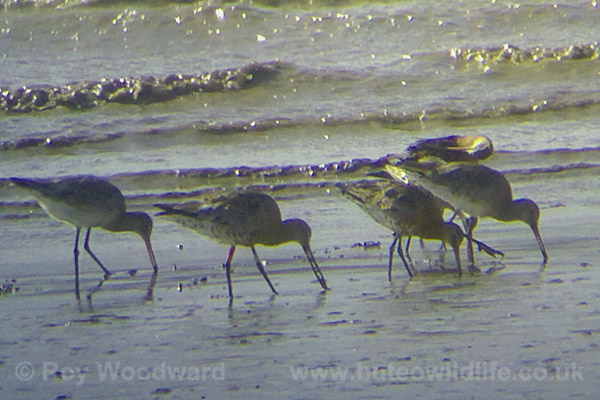For the last ELBF trip of the year we set off from Waltham Abbey on a blustery Sunday morning. An hour or so later we arrived at Canvey coastguard, wrapped up against the stiff south-westerly wind and went up to the watchpoint to see what we could find on the River Thames. There were a lot of Black-headed Gulls but, despite careful scrutiny, there did not appear to be any Mediterranean Gulls with them. A few Turnstones, an Oystercatcher and a Curlew flew past, and a distant diver was seen by one person but no one else managed to get onto it and its identity remained a mystery. a couple of small groups of Dark-bellied Brent Geese were seen in the distance but little else of note so we made our way back to the cars where there were Pied Wagtails flying over the car park.
We drove to the RSPB reserve at West Canvey where a single Fieldfare perched in a bush beside the car park but most passerines were keeping their heads down in the strong wind. The most obvious birds by the flash were a flock of Canada Geese but a bit of careful scanning turned up Wigeon, Teal and Shoveler, several Lapwing and Curlew in the fields and some Rabbits. A Little Grebe proved somewhat elusive on the flash but the Tufted Duck and Pochard were quite prominent. In view of the weather and the fact that the morning was nearly gone we decided to move on to Two-tree Island.
On arriving we made our way to the western end of the island, noting scattered Grey Plover and Ringed Plover, Redshank, Curlew, Turnstone and Dunlin on the way. On going into the hide at the end Avocets were quickly added to the day's list with twenty-one scattered around the pool. A Little Egret was seen at the far end of the pool and there were four Common Snipe dividing their time between sleeping almost hidden in the vegetation and feeding on the mud. There were a few more Grey Plover on the pool but we couldn't find any godwits anywhere. On the way back to the cars a Sparrowhawk flew across in front of us and a Kestrel was seen hovering over some of the scrub. We drove the short distance to the car park in the middle of the island and walked along to the eastern point. The scrub in this area was sheltered and we finally connected with some passerines. Chaffinches, Greenfinches and Goldfinches were all noted, there were a few Fieldfares and plenty of Blackbirds and, at a feeding station in the middle of the reserve, we added Great Tits, Blue Tits, Long-tailed Tits and Robin. There were no water birds on the reedy pool halfway to the point but we did hear a Dunnock. Arriving at the point we checked the mud looking towards Southend and quickly found a flock of Dark-bellied Brent Geese which numbered about a thousand birds. There were Oystercatchers out on the mud as well. As we began to head back with the light starting to fade Little Egrets began to fly in towards the island from the east and as we got to the area of the old sewage works there was a group of ivy-covered trees which was obviously the roosting point for the egrets as we watched about twenty come in and perch with much grunting and squawking. Unfortunately the hoped-for Short-eared Owl failed to show but on reaching the car park the light had faded enoough for Jupiter to be glowing brightly over Southend and, with the aid of a telescope three of its moons could be seen.





















































